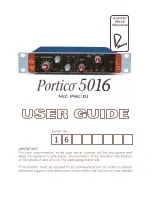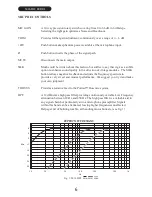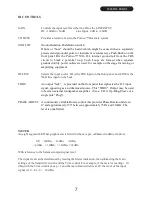
5016 MIC PRE/DI
9
The D.I. and LINE channel Outputs
The Output stage is identical with that of the Microphone Preamplifier Channel, driving a carefully
configured balanced and floating Output Transformer designed to safely feed long lines with up to
25 dBu.
Inter-connection of Professional equipment should always be carried out using balanced lines in
order to ensure freedom from interference and hum. A balanced line carries the "Send" and
"Return" music signals on two wires that are inside a screening outer lapped or woven "Ground"
mesh. So the Ground or Screen connection is not involved with carrying the music signal but is left
to do its job of protecting the music from outside garbage or power line currents that may be
circulating between modules or floating around a stage with powerful lighting.
Application Notes
The benefits of Variable Phase cover a number of powerful professional applications and include
"fun" effects that can add amazing treatments to the combination of sound sources.
D.I. (Direct) and a microphone signal are often combined to best capture the essence of the
instrument signal, together with that of the selected amplifier and room. However, acoustically
derived signals from a microphone can never be exactly phase-coherent when combined with
signals from a stringed instrument pickup or electronic keyboard, and these issues are only
exacerbated when the microphone is recording an amplified loudspeaker. These phase
cancellations and additions can be especially detrimental to the low end response.
Suggested Applications:
1. When using a traditional DI in combination with a microphone signal, the only option to alter
phase is to reverse the DI phase or to move the microphone to find the best possible combination
point. These methods force the engineer to take the microphone away from the "sweet spot" of the
speaker or instrument, and inches of difference in microphone position can greatly change how the
two sources combine in phase.
The Variable Phase control on the 5016 allows the direct signal to be rotated across a wide range,
enabling the microphone to be placed where it sounds best. When, in addition, Variable Phase is
combined with the Phase Reverse switch on the microphone preamp, very powerful control over
musical instrument recording is available.
2. When using Variable Phase on already recorded sources such as a snare drum mixed with
overheads, follow the same process. Patch the snare track into the XLR Line Level Input, and select
Line Input. To find the most phase coherent combination, sum the 3 signals to mono and reverse
the phase on both of the overhead channels. Adjust the Variable Phase control to rotate the phase of
the snare track until the sound of the snare drum is at it's minimum. Correct the phase on the
overhead tracks and listen to make sure the combination sounds as intended.
Summary of Contents for Portico 5016
Page 1: ......













